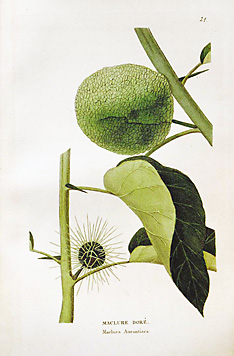Obdurate Osage Orange
By Audrey Stallsmith

Horse high, bull strong, and pig tight!
Professor Jonathan Turner
The above description was Professor Turner’s way of recommending the thorny and virtually indestructible osage orange (Maclura pomifera or aurantiaca) as a hedging shrub with which to fence in livestock. Although originally only native to the southern Osage country of Texas, Oklahoma, and Arkansas, the hardy orange would spread all across the U.S. as farmers constructed barriers and windbreaks with it.
In fact, some will hold that the inventors of barbed wire got their inspiration from the wicked 1/2 to 1-inch thorns which grow in the plant’s leaf axils. Even after that newfangled fencing had replaced the hedges, the osage orange still was in demand for fence posts, its rot-resistant and insect-impervious wood being one of the few that would stand up to long exposure to the elements.
Farmers and ranchers quickly learned to use green wood for those fence posts, though. When dry, osage orange reportedly becomes too hard to allow staples to penetrate it.
The Osage tribe and other native Americans had used that wood to make bows so strong that one of them was considered to be worth as much as a good horse. In fact, another of the tree’s nicknames, bodark, is derived from the French bois d’arc (“wood of the bow”).
Naturally, that wood also came to be prized for tool handles, wheel hubs, mine timbers, and railway ties. Since it has a yellowish hue, a dye made from it once was used to color army uniforms khaki.
The tree derives its genus name from William Maclure, an American geologist and founder of the Academy of Natural Sciences of Philadelphia, who also was among those who unsuccessfully tried to establish a socialist commune in New Harmony, Indiana. The species name pomifera means ‘fruit bearing” while its alternative aurantiaca simply means “orange.”
Actually about the size of grapefruits and sometimes called hedge apples, Maclura fruits do turn a yellowish green not-quite-orange in autumn and exhibit a bumpy texture that has been compared to the appearance of exposed brains. They reportedly have a cucumber-like flavor, but aren’t often eaten, since they ooze a white latex which can irritate the skin—and probably the mouth, as well. Their reputed ability to repel insects, though, often caused them to be brought indoors (presumably dried) to double as a decoration and deterrent.
The osage orange's tiny, pale green flowers appear in clusters in the spring, with the male and female ones on different trees. Although non-pollinated female blooms can produce fruits, those fruits won’t contain seeds.
The osage orange actually is more closely related to the mulberry than to the orange or apple. Granted, though, the trees do have a few citrus-y characteristics, such as glossy foliage (which turns yellow in autumn) and those already-mentioned thorns.
Despite early promise as a geologist, Maclure seems to have been one of those people who can’t quite connect with success, since a couple agriculture colleges he tried to found never seemed to get off the ground any more than the commune did. We can learn from him, though, because—like the tree which would be named for him—he knew how to persist.
Maclura aurantiaca image is by C. K. Schneid from Annales de flore et de Pomone, courtesy of plantillustrations.org.








